Colour rendering difference between copies (50:2 v4)
-
Recently Browsing 0 members
- No registered users viewing this page.
-
Similar Content
-
- 8 replies
- 1,389 views
-
- 9 replies
- 319 views
-
- 6 replies
- 1,483 views
-
Colour version
By pgk,
- 4 replies
- 372 views
-
- 29 replies
- 1,921 views
-




Recommended Posts
Join the conversation
You can post now and register later. If you have an account, sign in now to post with your account.
Note: Your post will require moderator approval before it will be visible.